Results of the 2015 National Assessment of Educational Progress (NAEP) in Reading and Mathematics were released October 28, 2015. Details are available here.
As in recent years, the 2015 performance of students with disabilities showed little if any improvement over the last three administrations (2009-2011-2013) and the gaps between students with disabilities and those without disabilities continue to be substantial. The majority of students with disabilities performed in the “below basic” achievement level in all areas except 4th grade Math. See table below.

However, there has been a substantial improvement in the rate of exclusion of students with disabilities, i.e., the percentage of students with disabilities selected to participate in the sample who were not tested. This practice was addressed by a resolution of the National Assessment Governing Board in 2010. The resolution sought to have students with disabilities participating at a rate of at least 85% in every state. As a result, exclusion rates have plummeted, as shown in the table below. This high rate of participation makes the NAEP results for students with disabilities more representative of the group as a whole. (Details on exclusion rates by state on each NAEP assessment are available here.)
NAEP participation was also addressed by the US ED Office of Special Education Programs in 2014 when it began including NAEP participation and performance in the determination for each State under section 616(d) of the Individuals with Disabilities Education Act (IDEA).
The table below shows the rates of exclusion in NAEP administrations from 2003-2015.

In fact, the significant improvement in testing students with disabilities was noted by U.S. Education Secretary Arne Duncan as possibly causing overall declines in Maryland, as reported in the Baltimore Sun “U.S. Secretary of Education Arne Duncan noted to Maryland and Baltimore’s large declines, but said the drops were “good news” because they reflected the state’s efforts to be more inclusive of certain populations — such as students with disabilities and English Language Learners.”
Below are achievement levels for students with disabilities and students without disabilities in each NAEP area from 2003 through 2015.
READING – GRADE 4
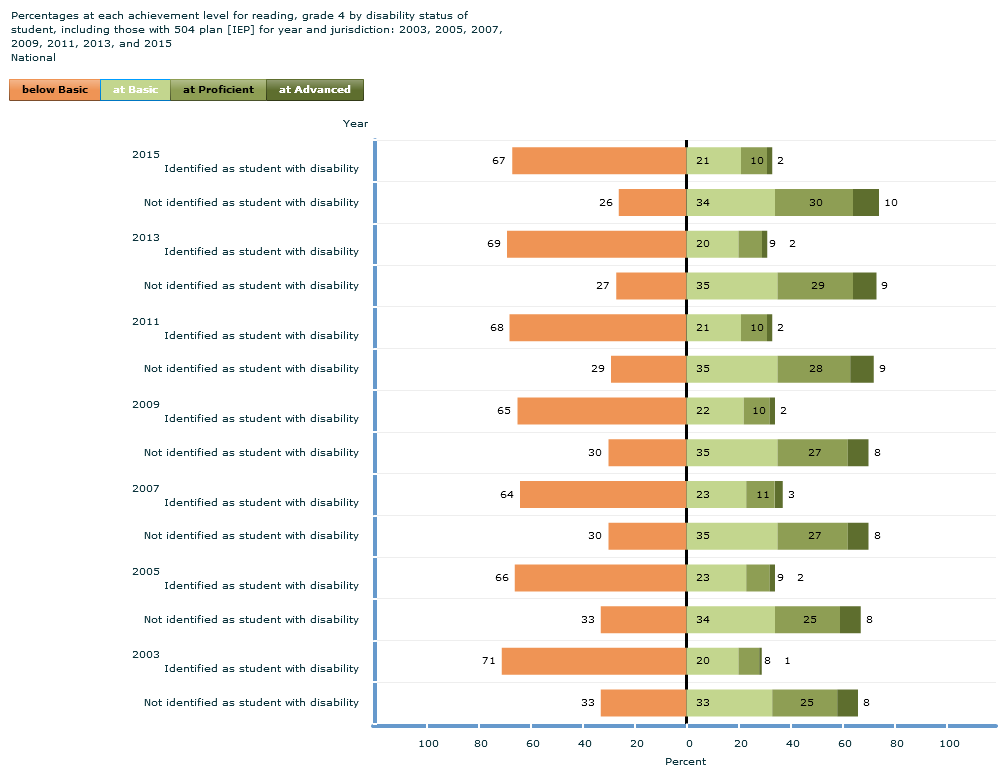
READING GRADE 8
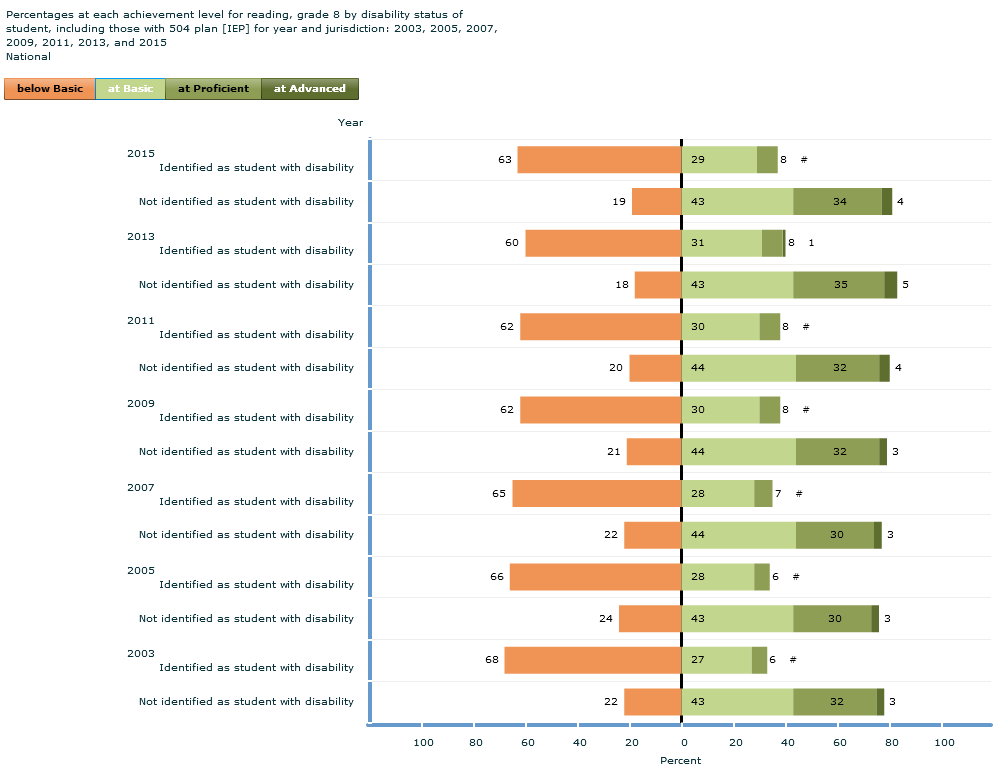
MATH GRADE 4
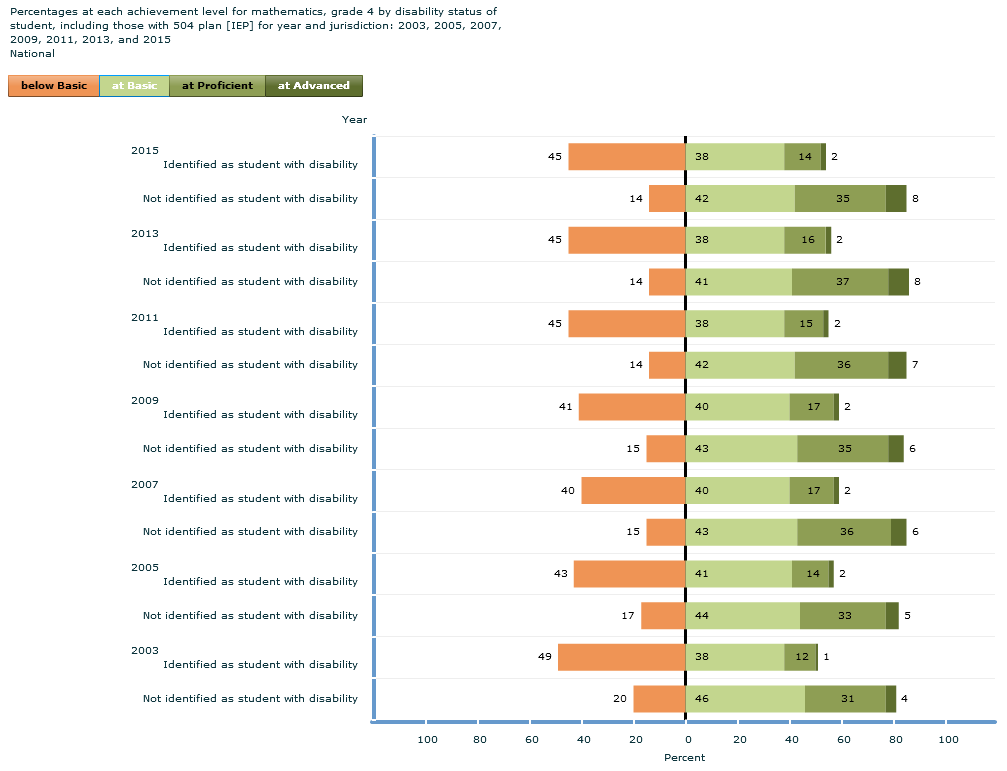
MATH GRADE 8
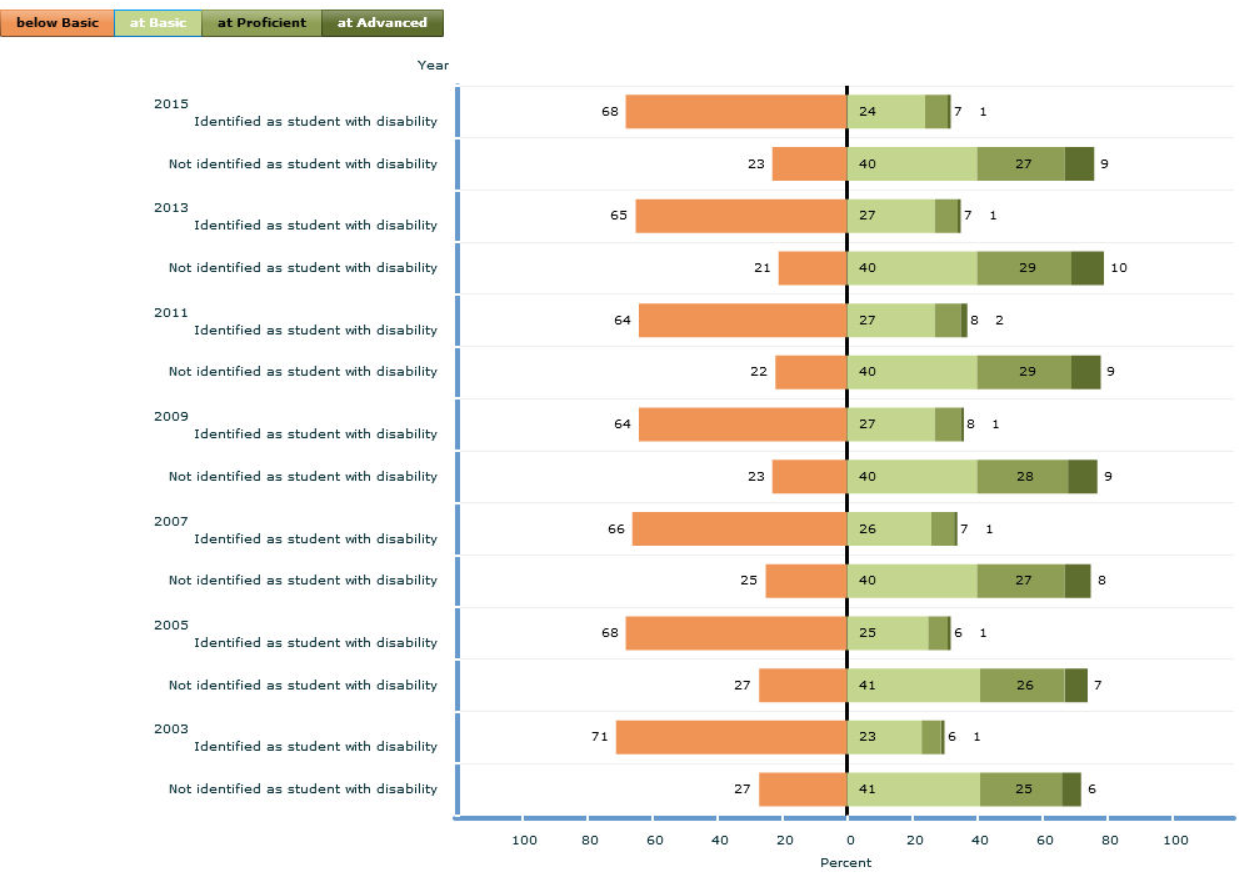
See also: Our reports on 2015 TUDA and 2013 NAEP results.
On October 19, 2015, the U.S. Dept. of Education (ED) released preliminary graduation rates reported by states for the 2013-14 school year.
According to ED “The vast majority of states – 36 – saw increases in overall graduation rates, while 6 states saw decreases and another 8 saw no change since 2012-13. The majority of states also shrank the achievement gap for black and Hispanic students, as well as students with disabilities, English language learners and low-income students”
ED reported that 21 states showed a decline in the graduation rate gap between all students and students with disabilities, 17 states had increases in the gap and 12 states showed no change.
Our analysis (below) found 21 states and D.C. decreased, 15 increased and 14 had no change (the difference could be caused by rounding). Two states are outliers – Alabama (19 point gap increase) and Oregon (gap decrease of 11 points).
Most states had negligible changes (a decrease or increase of just 1-2 points) which could be characterized as statistically insignificant.
Without a doubt, the bigger issue continues to be the huge gaps between students with disabilities and all students earning a regular high school diploma in four years.
Four Year Adjusted Cohort Graduation Rate
Gaps between All Students and Students with Disabilities
SY 2012-13 and SY 2013-14

Download ACGR Comparison Chart .
See also: Study Finds Wide Variation in Graduation Rates for Students with Disabilities; Little Relationship with Graduation Policies
December saw the release of the results of the 2013 TUDA – the Trial Urban District Assessment – part of the National Assessment of Educational Progress (NAEP) conducted by the U.S. Dept. of Education. (We blogged about the release of the NAEP at the state and national levels earlier.)
The TUDA reports the achievement of public school students in 21 urban districts in reading and math at grades 4 and 8. Results are broken down by racial/ethnic groups as well as special populations, such as students with disabilities and students eligible for free/reduced-price lunch meals. More info on TUDA is available here.
The achievement of students with disabilities (including both IDEA and 504 eligible students) varied substantially across the TUDAs. However, few districts achieved at a level equal to or better than the nationwide level for students with disabilities.
While most participating districts performed below the nationwide rate on all measures, some districts stand out as exceedingly poor performers. Only one district achieved exceptionally good performance when compared to the nation as a whole. These are:
EXCEEDINGLY POOR (in alphabetical order): Cleveland, Detroit, Fresno, Los Angeles, Milwaukee
EXCEPTIONALLY GOOD: Hillsborough County (FL)
Hillsborough County in Florida was the only district participating in TUDA that outperformed the nation on all four measures (4th/8th Reading and Math). Hillsborough’s TUDA results were reported in the Tampa Bay Newswire.
The performance of students with disabilities compared to those without disabilities is shown below.
MATH – Grade 4

MATH – Grade 8

READING – Grade 4

READING – Grade 8

The results of the 2013 National Assessment of Educational Progress (NAEP) in Reading and Math were released today. Details are available here. User-friendly digital tools let you display results by state and student groups such as students with disabilities.
Sadly, the performance of students with disabilities has shown little if any improvement over the last three administrations (2009-2011-2013) and the gaps between students with disabilities and those without disabilities continue to be substantial.
However, there has been a substantial improvement in the rate of exclusion of students with disabilities, i.e., the percentage of students with disabilities selected to participate in the sample who were not tested. This practice was addressed by a resolution of the National Assessment Governing Board in 2010. The resolution sought to have students with disabilities participating at a rate of at least 85% in every state. As a result, exclusion rates have plummeted, as shown in the table below. This high rate of participation makes the NAEP results for students with disabilities more representative of the group as a whole. However, high exclusion rates still exist in some states, such as California, Georgia and Maryland. Details on exclusion rates by state on each NAEP assessment are available here.

Turning to achievement, students with disabilities continue to perform poorly on all NAEP measures.
READING – 4TH GRADE:
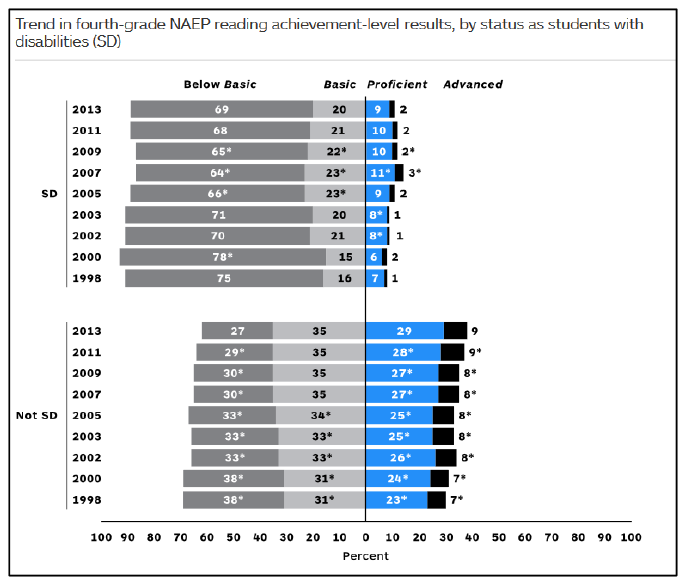
READING – 8TH GRADE:

MATH – 4TH GRADE:

MATH – 8TH GRADE:

The U.S. Dept. of Education has released the first round of high school graduation rate data compiled based upon the common measure known as the “four-year adjusted cohort rate” required by a 2008 federal regulation.
The four-year adjusted cohort graduation rate is the number of students who graduate in four years with a regular high school diploma divided by the number of students who form the adjusted cohort for the graduating class. From the beginning of 9th grade (or the earliest high school grade), students who are entering that grade for the first time form a cohort that is “adjusted” by adding any students who subsequently transfer into the cohort and subtracting any students who subsequently transfer out, emigrate to another country, or die.
For the first time, graduation rates can be compared across states and across student groups, such as students with disabilities. Graduation rate data for all states and all student groups is available here.
Below is a comparison of the graduation rate for all students and students with disabilities by state (note: data for ID, KY, OK, and PR are not available).
Some highlights:
- Graduation rates for students with disabilities range from a high of 84% (SD) to a low of 23% (MS and NV)
- Mississippi has the largest gap in graduation rates at 52%
- Seven states have graduation gaps of 35% or greater (MS, AL, LA, NV, GA, SC, VA)
- Twenty-five states have graduation gaps of 20% or greater

















